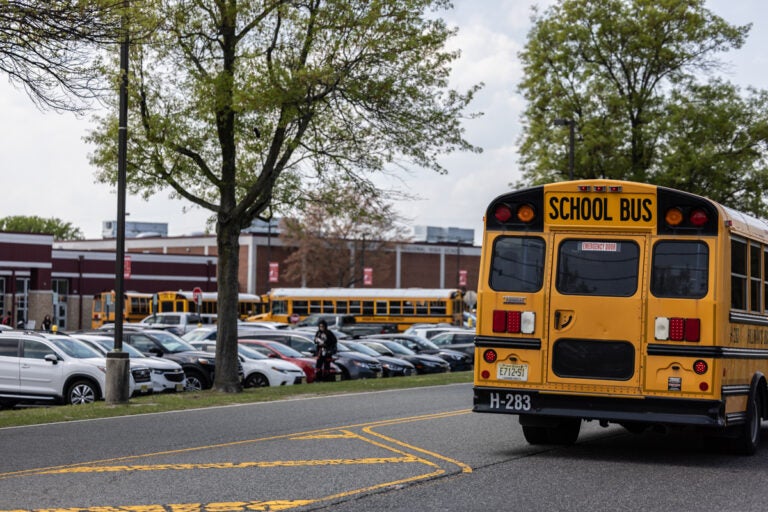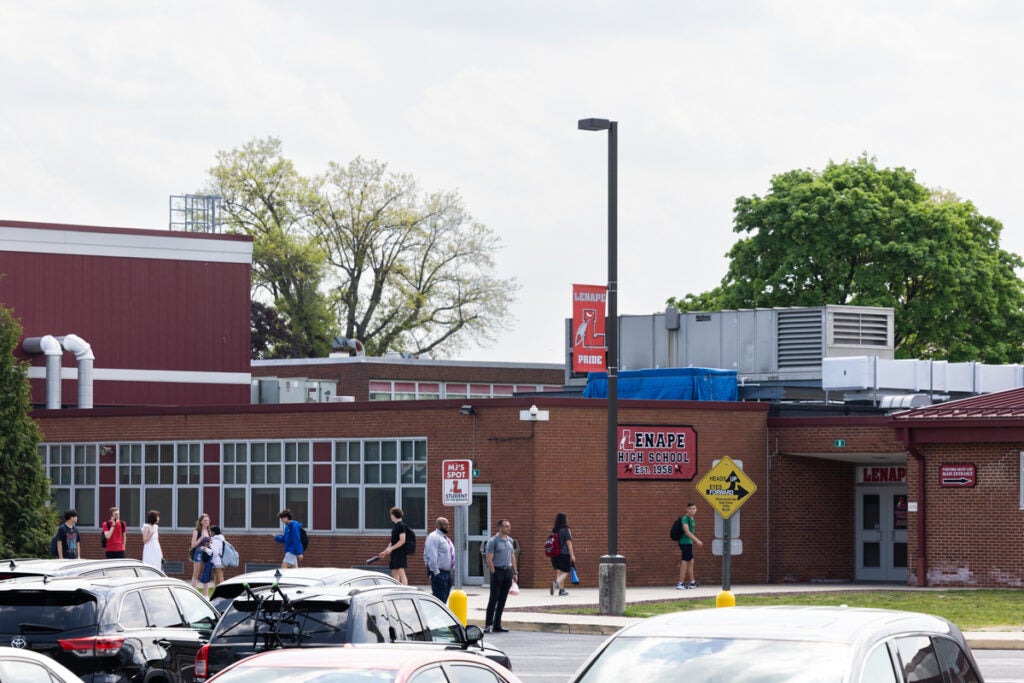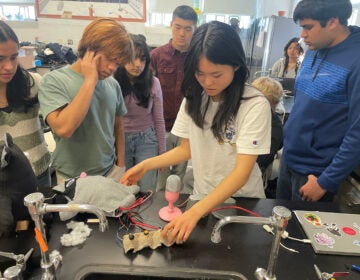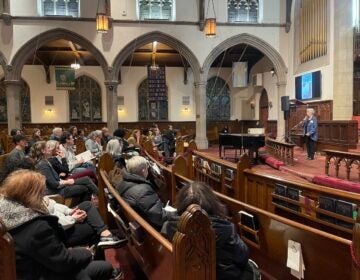South Jersey schools would bear the brunt of proposed state aid cuts, led by Burlington County
An analysis by WHYY News shows that 15 school districts in Burlington County would see some kind of cut in state aid.

Lenape High School in Medford, N.J. (Kimberly Paynter/WHYY)
From Camden and Cherry Hill to Trenton and the Jersey Shore, what about life in New Jersey do you want WHYY News to cover? Let us know.
Nearly half of the 140 school districts facing cuts in New Jersey Gov. Phil Murphy’s proposed budget are in South Jersey, according to a WHYY News analysis. At least 30 districts are facing cuts of at least 10%.
Burlington County, overall, has the most number of districts that will experience reductions in aid.
“It’s not fair,” said state Sen. Latham Tiver, who represents a part of Burlington County where ten school districts are experiencing cuts in state aid. Using the Lenape Regional High School District as an example, Tiver said officials were not expecting reduced state funding of almost 20% or $4.7 million.
“It’s impossible for them to plan ahead from year to year when they don’t know what they’re going to get cut,” he added.

State Sen. Troy Singleton was “deeply disappointed” when he saw five school districts in his part of the county would receive cuts in state aid. He added school officials face “an enormous amount of pressure” because of deadlines that school districts must meet when crafting their budgets for next year.
“The districts have to send their budgets up to Trenton by the end of April. And they alert teachers in early May as to whether or not they will be funding their positions or whether or not they have to make cuts,” he said. “The dichotomy of the differences in dates really creates a lot of tension for both local school officials and for state officials who have ultimately to sign off on the approving of additional resources.”
How New Jersey’s school funding formula works
- Aid is based on “enrollment and characteristics of the students served. Also accounting for the community’s economics in determining the level of state support needed to educate those students,” according to the N.J. Department of Education
- A district’s ability to raise revenue is also factored into the amount of aid from the state
- Yearly changes in aid are: closely related to the district’s enrollment; proportion of low-income students; number of students with limited English proficiency; number of special education students; and student grade levels
- Districts also receive additional aid not adjusted by “community factors” to cover transportation and security, among other categories
Among the counties comprising South Jersey, Burlington County has the highest median household income at $102,615, according to the latest census estimates. Gloucester County comes close with $99,668. However, nine districts in that county are seeing some type of reduction in state aid.
Parents in the Lumberton School District were not surprised by a proposed cut of more than $1 million or 21.5% of their state aid.
“We’ve known about this state formula now for seven years,” said Rue Ryan, a parent of two students in the district. “We’ve known that Lumberton was going to be a district that was going to get hit with cuts.”
The district tells WHYY News that it lost about $11 million in state aid over the last several years.
Troy Green, the parent of four students, is concerned that the district is “already under budget” and “undercut” financially.
“Now we’re losing more money, which is going to hurt us even more,” he said.

Lumberton Superintendent Dr. Colleen Murray said they’ve looked across the district to find efficiencies.
“We’ve done everything we can with digitizing things, saving on paper, cutting down administrative staff,” she said. “Now it’s to the point where we have to look at programs and people.”
Murray hopes a stabilization bill to restore some of the funding will pass the Legislature in time to hold on to staff members. It passed the Assembly on April 15, but the Senate has yet to take it up.
Details of what school districts will receive in state aid were not realized until Gov. Phil Murphy presented his 2025 budget proposal toward the end of February. His administration said the proposal fully funds the state’s school funding formula for the first time since it was enacted 15 years ago.
Republican leaders in the Legislature criticized the cuts as part of a larger slamming of Murphy’s budget proposal.
Not all South Jersey districts will experience cuts.
Schools in Cumberland County will see an increase in aid over last year. It is the poorest county in the state, with a median income of $62,310 and a poverty rate of 15.5%
Singleton and Tiver are sponsoring a measure that would reconfigure how funding is distributed within the state’s school funding formula.
“Essentially, every school district would receive an increase of 4.5%, which is consistent with the consumer price index here in our region,” Singleton said, adding that some districts would get more based on tougher economic climates.
“And then, we’d still – within the existing pot of money in the school funding formula – we would still have an additional pot of money in the neighborhood of about $300 to 350 or so million, that would … be utilized by the Department of Education to provide additional resources to support districts that make a case that, hey, we needed a little bit more for this reason or that.”
A formula for tension and pressure
The numbers that the Education Department calculated are guided by the School Funding Reform Act of 2008, or SFRA. A revision, known in Trenton as “S2,” was added in 2018.
Before SFRA, school funding reform was driven by a series of court decisions, according to Dr. Mark Weber, senior analyst for education policy at New Jersey Policy Perspective, starting with Robinson v. Cahill in the early 1970s and continuing through several Abbott Decisions starting in the mid-1980s.
The formula is based, in part, on a district’s ability to raise revenue.
“[With SFRA] the legislature said, ‘Okay, we’re going to help all districts, every district,’” he said. “We’re going to provide the aid for you that is commensurate with your ability to be able to tax yourself and with the population of students that you are educating,” he said.
Once the formula was executed, the amount of aid given was changed after some districts complained, and lawmakers moved to preserve funding for those districts.
Another factor was when Gov. Chris Christie, in 2010, put in place a 2% cap on annual property tax increases, limiting a district’s ability to raise revenue. A measure to allow districts to exceed the cap was proposed over the winter.
Weber said SFRA is not a “complete disaster,” but it could be better while defending the fundamental core of the law.
“The idea that if you have more students who have greater needs, you should get more funding,” he said. “If you have a community that doesn’t have the ability to raise enough in taxes, you should get more funding.”
Weber believes the problem is in the “nuts and bolts” of the law.
“There are…specific parts of SFRA that are subjected to economic swings and all kinds of volatility that school districts really don’t expect,” he said. “All it takes is a few changes in property values for your district, particularly if you’re a small district, you may be expected to contribute a lot more.”
Better funding targets with real data plus a more careful look at “local fair share” are a couple of ideas that Weber offered to improve SFRA.
What the long-term fix will look like remains to be seen according to Gov. Murphy. During the April edition of WHYY’s “Ask Governor Murphy” program, he said a conversation with all parties would be needed.
“Not just the legislators, but certainly them and our team, but also the stakeholders,” said Murphy. “Whether that’s superintendents, principals, the teachers’ unions, moms and dads; let’s get around a table and figure out where this is working and where it isn’t working.”

Get daily updates from WHYY News!
WHYY is your source for fact-based, in-depth journalism and information. As a nonprofit organization, we rely on financial support from readers like you. Please give today.





